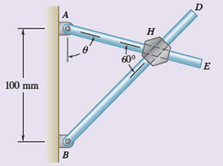
Concept explainers
Two rods AE and BD pass through holes drilled into a hexagonal block. (The holes are drilled in different planes so that the rods will not touch each other.) Knowing that rod AE has an angular velocity of 20 rad/s clockwise and an angular acceleration of 4 rad/s2 counterclockwise when

Fig. P15.257
(a)
Relative velocity of block with respect to each rod.
Answer to Problem 15.257RP
Relative velocity of block with respect to each rod
Explanation of Solution
Given information:

The angular velocity and angular acceleration of rod AE is
The Coriolis acceleration is a combination of
The Coriolis acceleration id defined as
The velocity is defined as
The normal acceleration is defined as
The tangential acceleration is defined as
Calculation:
When

Apply sine rule,
Therefore,
The angle
Assume, the relative velocity of slider H on rod AH is
The velocity of point
The acceleration of point
The relevant Coriolis acceleration is
The velocity of point H,
The acceleration of point H
Assume, the relative velocity of slider H on rod BD is
The velocity of point
The acceleration of point
The relevant Coriolis acceleration
The velocity of point H,
The acceleration of point H
Equate
Therefore, the relative velocities
Conclusion:
The relative velocities of each rod
(b)
Relative acceleration of block with respect to each rod.
Answer to Problem 15.257RP
Relative acceleration of block with respect to each rod
Explanation of Solution
Given information:

The angular velocity and angular acceleration of rod AE is
The Coriolis acceleration is a combination of
The Coriolis acceleration id defined as
The velocity is defined as
The normal acceleration is defined as
The tangential acceleration is defined as
Calculation:
According to sub part a
Substitute for
Therefore
Therefore
Conclusion:
The relative acceleration of each rod
Want to see more full solutions like this?
Chapter 15 Solutions
Vector Mechanics For Engineers
- PROBLEM 3.46 The solid cylindrical rod BC of length L = 600 mm is attached to the rigid lever AB of length a = 380 mm and to the support at C. When a 500 N force P is applied at A, design specifications require that the displacement of A not exceed 25 mm when a 500 N force P is applied at A For the material indicated determine the required diameter of the rod. Aluminium: Tall = 65 MPa, G = 27 GPa. Aarrow_forwardFind the equivalent mass of the rocker arm assembly with respect to the x coordinate. k₁ mi m2 k₁arrow_forward2. Figure below shows a U-tube manometer open at both ends and containing a column of liquid mercury of length l and specific weight y. Considering a small displacement x of the manometer meniscus from its equilibrium position (or datum), determine the equivalent spring constant associated with the restoring force. Datum Area, Aarrow_forward
- 1. The consequences of a head-on collision of two automobiles can be studied by considering the impact of the automobile on a barrier, as shown in figure below. Construct a mathematical model (i.e., draw the diagram) by considering the masses of the automobile body, engine, transmission, and suspension and the elasticity of the bumpers, radiator, sheet metal body, driveline, and engine mounts.arrow_forward3.) 15.40 – Collar B moves up at constant velocity vB = 1.5 m/s. Rod AB has length = 1.2 m. The incline is at angle = 25°. Compute an expression for the angular velocity of rod AB, ė and the velocity of end A of the rod (✓✓) as a function of v₂,1,0,0. Then compute numerical answers for ȧ & y_ with 0 = 50°.arrow_forward2.) 15.12 The assembly shown consists of the straight rod ABC which passes through and is welded to the grectangular plate DEFH. The assembly rotates about the axis AC with a constant angular velocity of 9 rad/s. Knowing that the motion when viewed from C is counterclockwise, determine the velocity and acceleration of corner F.arrow_forward
 Elements Of ElectromagneticsMechanical EngineeringISBN:9780190698614Author:Sadiku, Matthew N. O.Publisher:Oxford University Press
Elements Of ElectromagneticsMechanical EngineeringISBN:9780190698614Author:Sadiku, Matthew N. O.Publisher:Oxford University Press Mechanics of Materials (10th Edition)Mechanical EngineeringISBN:9780134319650Author:Russell C. HibbelerPublisher:PEARSON
Mechanics of Materials (10th Edition)Mechanical EngineeringISBN:9780134319650Author:Russell C. HibbelerPublisher:PEARSON Thermodynamics: An Engineering ApproachMechanical EngineeringISBN:9781259822674Author:Yunus A. Cengel Dr., Michael A. BolesPublisher:McGraw-Hill Education
Thermodynamics: An Engineering ApproachMechanical EngineeringISBN:9781259822674Author:Yunus A. Cengel Dr., Michael A. BolesPublisher:McGraw-Hill Education Control Systems EngineeringMechanical EngineeringISBN:9781118170519Author:Norman S. NisePublisher:WILEY
Control Systems EngineeringMechanical EngineeringISBN:9781118170519Author:Norman S. NisePublisher:WILEY Mechanics of Materials (MindTap Course List)Mechanical EngineeringISBN:9781337093347Author:Barry J. Goodno, James M. GerePublisher:Cengage Learning
Mechanics of Materials (MindTap Course List)Mechanical EngineeringISBN:9781337093347Author:Barry J. Goodno, James M. GerePublisher:Cengage Learning Engineering Mechanics: StaticsMechanical EngineeringISBN:9781118807330Author:James L. Meriam, L. G. Kraige, J. N. BoltonPublisher:WILEY
Engineering Mechanics: StaticsMechanical EngineeringISBN:9781118807330Author:James L. Meriam, L. G. Kraige, J. N. BoltonPublisher:WILEY





